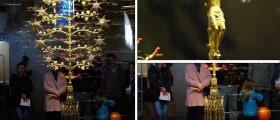> Home > >

Albero d'oro Lucignano
Year: 1350 - 1471
Current location: Museo Comunale di Lucignano
Original location: San Francesco a Lucignano
DESCRIPTIVE INFORMATION
The 'Tree of Life, or Golden Tree or even Love Tree is kept in a slanted window, at the center of Lucignano Museum.
The Tree is a great reliquary: small caskets trefoil hung in pairs on each of its twelve branches retained once Franciscan relics and splinters of the Cross of Christ. The work belongs to the type of reliquaries phytomorphic, ie which reproduce the forms of the vegetable world, and though formerly very common today are preserved only a few specimens, and among these, that of Lucignano stands out for its grandeur, complexity and value. As stated in a long inscription that runs along the foot of the Tree, the beginning of the work dates from 1350. However, it was only completed in 1471, 120 years later, at the hands of the Master goldsmith Gabriello d'Antonio da Siena. < br>
The tree contains, in its tripartite morphological (root, trunk and crown) the metaphor of Christ's life in three different phases, origin, passion and glory, as it is developed in the lignum vitae, a mystical poem by Bonaventure (1260) . The base quatrefoil supports the stem, on which are grafted before a small temple in the Gothic style and then the twelve branches, finally, on top of the Tree are a crucified Christ and a pelican, the Christological symbol of the animal that is injured to death to nourish their young. The medallions that decorate the branches contain at the front of the miniatures on parchment depicting the prophets, while in the back of the New Testament characters of embossed and enamelled silver.
The tree was kept in St. Francis, in a painted wooden cabinet, according to a contract between the convent and the painter Luca Signorelli from Cortona, one of the most prestigious artists of the moment, but of which no trace remains. On the night of September 28, 1914 the tree was stolen and he was found, dismantled and partly damaged, only in November 1917 in a cave in the vicinity of Sarteano and then restored by the Opificio delle Pietre Dure in Florence.
Around the Tree, symbol of Divine Love, has flourished a local legend that brings good luck to lovers exchange promises of love before his branches.
Albero d'oro




